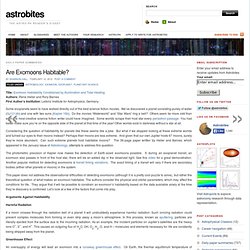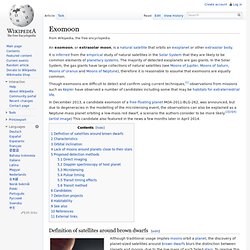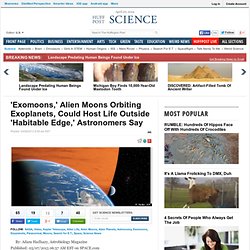

The 'Habitable Edge' of Exomoons. MessageToEagle.com - Exomoons, moons of alien planets have many hurdles to habitability, such as eclipses and tidal heating, that are different from the planets they orbit.

Astronomers have their fingers crossed that within the haul of data collected by NASA's Kepler mission, which has already detected nearly three thousand possible exoplanets, hide the signatures of the very first exomoons. The discovery of alien moons will open up an exciting new frontier in the continuing hunt for habitable worlds outside the Solar System. With the confirmation of exomoons likely right around the corner, researchers have begun addressing the unique and un-Earthly factors that might affect their habitability. Because exomoons orbit a larger planetary body, they have an additional set of constraints on their potential livability than planets themselves. Examples include eclipses by their host planet, as well as reflected sunlight and heat emissions. The "habitable edge" Basking in the glow Roll tides. Are Exomoons Habitable? Title:Exomoon Habitability Constrained by Illumination and Tidal HeatingAuthors: Rene Heller and Rory BarnesFirst Author’s Institution: Leibniz Institute for Astrophysics, Germany Some exoplanets seem to have walked directly out of the best science fiction movies.

We’ve discovered a planet consisting purely of water (GJ1214b) and one with two suns (Kepler 16b). Do the movies “Waterworld” and “Star Wars” ring a bell? Others seem far more odd than even the most creative science fiction writer could have imagined. Some worlds scrape their host star every periastron passage. Considering the question of habitability for planets like these seems like a joke. The photometric precision of Kepler now makes the detection of Earth-sized exomoons possible. This paper does not address the observational difficulties of detecting exomoons (although it is a pretty cool puzzle to solve), but rather the theoretical question of what makes an exomoon habitable.
Arguments Against Habitability Illumination. Extrasolar moon. An exomoon, or extrasolar moon, is a natural satellite that orbits an exoplanet or other extrasolar body.

It is inferred from the empirical study of natural satellites in the Solar System that they are likely to be common elements of planetary systems. The majority of detected exoplanets are gas giants. In the Solar System, the gas giants have large collections of natural satellites (see Moons of Jupiter, Moons of Saturn, Moons of Uranus and Moons of Neptune), therefore it is reasonable to assume that exomoons are equally common. In December 2013, a candidate exomoon of a free-floating planet MOA-2011-BLG-262, was announced, but due to degeneracies in the modelling of the microlensing event, the observations can also be explained as a Neptune-mass planet orbiting a low-mass red dwarf, a scenario the authors consider to be more likely.[2][3][4] (artist image) This candidate also featured in the news a few months later in April 2014.
Definition of satellites around brown dwarfs[edit] 'Exomoons,' Alien Moons Orbiting Exoplanets, Could Host Life Outside 'Habitable Edge,' Astronomers Say. By: Adam Hadhazy, Astrobiology Magazine Published: 03/07/2013 06:57 AM EST on SPACE.com Astronomers have their fingers crossed that within the haul of data collected by NASA's Kepler mission, which has already detected nearly 3,000 possible exoplanets, hide the signatures of the very first exomoons.

The discovery of alien moons will open up an exciting new frontier in the continuing hunt for habitable worlds outside the solar system. With the confirmation of exomoons likely right around the corner, researchers have begun addressing the unique and un-Earthly factors that might affect their habitability. Because exomoons orbit a larger planetary body, they have an additional set of constraints on their potential livability than exoplanets themselves. Examples include eclipses by their host planet, as well as reflected sunlight and heat emissions. The 'habitable edge' The habitable edge is rather different. Basking in the glow Periodic plunges into darkness Roll tides Small stars, dead moons.